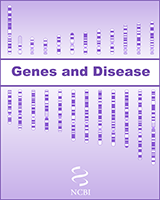NCBI Bookshelf. A service of the National Library of Medicine, National Institutes of Health.
National Center for Biotechnology Information (US). Genes and Disease [Internet]. Bethesda (MD): National Center for Biotechnology Information (US); 1998-.
Charcot-Marie-Tooth disease (CMT) is named after its three discoverers, who first noted the disease around the turn of the century. It is the most common inherited peripheral neuropathy in the world, characterized by a slowly progressive degeneration of the muscles in the foot, lower leg, hand, and forearm and a mild loss of sensation in the limbs, fingers, and toes. Full expression of CMT's clinical symptoms generally occurs by age 30. CMT is not a fatal disease, however, and the disorder does not affect normal life expectancy.
CMT is a genetically heterogeneous disorder in which mutations in different genes can produce the same clinical symptoms. In CMT there are not only different genes but different patterns of inheritance. One of the most common forms of CMT is Type 1A. The gene for Type 1A CMT maps to chromosome 17 and is thought to code for a protein (PMP22) involved in coating peripheral nerves with myelin, a fatty sheath that is important for their conductance. Other types of CMT include Type 1B, autosomal-recessive, and X-linked.
The same proteins involved in the Type 1A and Type 1B CMT are also involved in a disease called Dejerine-Sottas Syndrome (DSS), in which similar clinical symptoms are presented, but they are more severe. Research into understanding the pathogenesis of CMT, through the use of animal models for the disease, should also give insight into DSS and may lead to therapies for both diseases.
- Genome view see gene locations
- Entrez Gene collection of gene-related information
- BLink related sequences in different organisms
- Research articles online full text
- Books online books section
- OMIM catalog of human genes and disorders
- GeneReviews a medical genetics resource
- Charcot-Marie-Tooth Association patient support, education and research
- Charcot-Marie-Tooth syndrome - Genes and DiseaseCharcot-Marie-Tooth syndrome - Genes and Disease
Your browsing activity is empty.
Activity recording is turned off.
See more...
